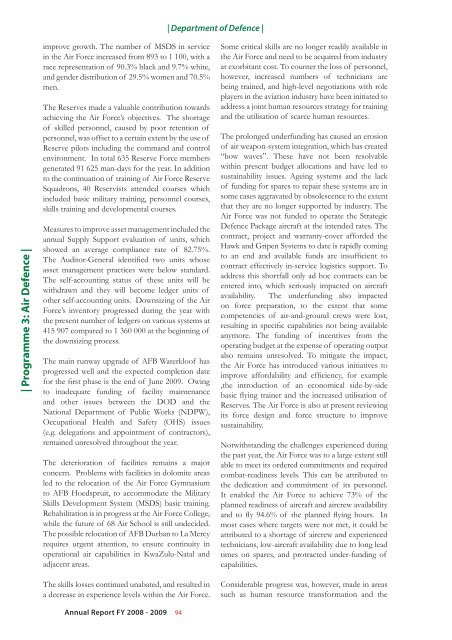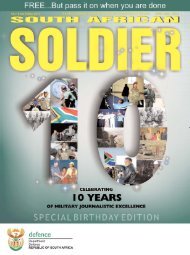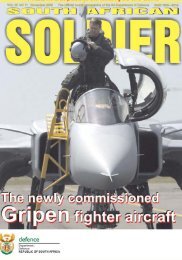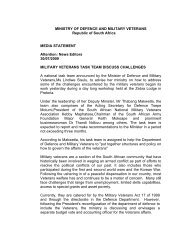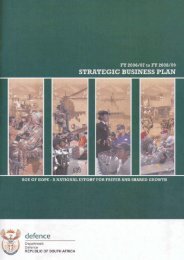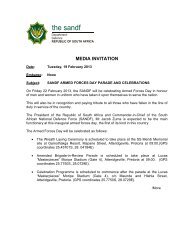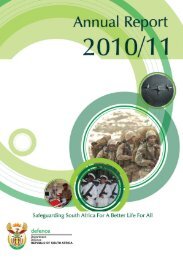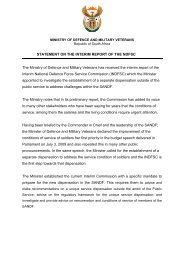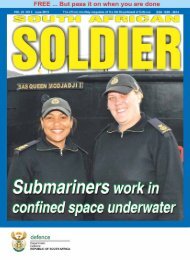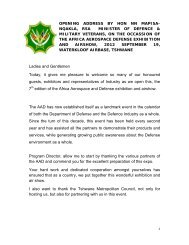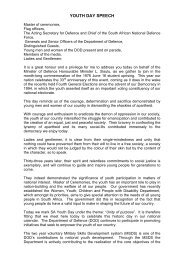Department of Defence Annual Report 2008-2009
Department of Defence Annual Report 2008-2009
Department of Defence Annual Report 2008-2009
- No tags were found...
You also want an ePaper? Increase the reach of your titles
YUMPU automatically turns print PDFs into web optimized ePapers that Google loves.
| <strong>Department</strong> <strong>of</strong> <strong>Defence</strong> |<br />
| Programme 3: Air <strong>Defence</strong> |<br />
improve growth. The number <strong>of</strong> MSDS in service<br />
in the Air Force increased from 893 to 1 100, with a<br />
race representation <strong>of</strong> 90.3% black and 9.7% white,<br />
and gender distribution <strong>of</strong> 29.5% women and 70.5%<br />
men.<br />
The Reserves made a valuable contribution towards<br />
achieving the Air Force’s objectives. The shortage<br />
<strong>of</strong> skilled personnel, caused by poor retention <strong>of</strong><br />
personnel, was <strong>of</strong>fset to a certain extent by the use <strong>of</strong><br />
Reserve pilots including the command and control<br />
environment. In total 635 Reserve Force members<br />
generated 91 625 man-days for the year. In addition<br />
to the continuation <strong>of</strong> training <strong>of</strong> Air Force Reserve<br />
Squadrons, 40 Reservists attended courses which<br />
included basic military training, personnel courses,<br />
skills training and developmental courses.<br />
Measures to improve asset management included the<br />
annual Supply Support evaluation <strong>of</strong> units, which<br />
showed an average compliance rate <strong>of</strong> 82.75%.<br />
The Auditor-General identied two units whose<br />
asset management practices were below standard.<br />
The self-accounting status <strong>of</strong> these units will be<br />
withdrawn and they will become ledger units <strong>of</strong><br />
other self-accounting units. Downsizing <strong>of</strong> the Air<br />
Force’s inventory progressed during the year with<br />
the present number <strong>of</strong> ledgers on various systems at<br />
415 907 compared to 1 360 000 at the beginning <strong>of</strong><br />
the downsizing process.<br />
The main runway upgrade <strong>of</strong> AFB Waterklo<strong>of</strong> has<br />
progressed well and the expected completion date<br />
for the rst phase is the end <strong>of</strong> June <strong>2009</strong>. Owing<br />
to inadequate funding <strong>of</strong> facility maintenance<br />
and other issues between the DOD and the<br />
National <strong>Department</strong> <strong>of</strong> Public Works (NDPW),<br />
Occupational Health and Safety (OHS) issues<br />
(e.g. delegations and appointment <strong>of</strong> contractors),<br />
remained unresolved throughout the year.<br />
The deterioration <strong>of</strong> facilities remains a major<br />
concern. Problems with facilities in dolomite areas<br />
led to the relocation <strong>of</strong> the Air Force Gymnasium<br />
to AFB Hoedspruit, to accommodate the Military<br />
Skills Development System (MSDS) basic training.<br />
Rehabilitation is in progress at the Air Force College,<br />
while the future <strong>of</strong> 68 Air School is still undecided.<br />
The possible relocation <strong>of</strong> AFB Durban to La Mercy<br />
requires urgent attention, to ensure continuity in<br />
operational air capabilities in KwaZulu-Natal and<br />
adjacent areas.<br />
Some critical skills are no longer readily available in<br />
the Air Force and need to be acquired from industry<br />
at exorbitant cost. To counter the loss <strong>of</strong> personnel,<br />
however, increased numbers <strong>of</strong> technicians are<br />
being trained, and high-level negotiations with role<br />
players in the aviation industry have been initiated to<br />
address a joint human resources strategy for training<br />
and the utilisation <strong>of</strong> scarce human resources.<br />
The prolonged underfunding has caused an erosion<br />
<strong>of</strong> air weapon-system integration, which has created<br />
“bow waves”. These have not been resolvable<br />
within present budget allocations and have led to<br />
sustainability issues. Ageing systems and the lack<br />
<strong>of</strong> funding for spares to repair these systems are in<br />
some cases aggravated by obsolescence to the extent<br />
that they are no longer supported by industry. The<br />
Air Force was not funded to operate the Strategic<br />
<strong>Defence</strong> Package aircraft at the intended rates. The<br />
contract, project and warranty-cover afforded the<br />
Hawk and Gripen Systems to date is rapidly coming<br />
to an end and available funds are insufcient to<br />
contract effectively in-service logistics support. To<br />
address this shortfall only ad hoc contracts can be<br />
entered into, which seriously impacted on aircraft<br />
availability. The underfunding also impacted<br />
on force preparation, to the extent that some<br />
competencies <strong>of</strong> air-and-ground crews were lost,<br />
resulting in specic capabilities not being available<br />
anymore. The funding <strong>of</strong> incentives from the<br />
operating budget at the expense <strong>of</strong> operating output<br />
also remains unresolved. To mitigate the impact,<br />
the Air Force has introduced various initiatives to<br />
improve affordability and efciency, for example<br />
,the introduction <strong>of</strong> an economical side-by-side<br />
basic ying trainer and the increased utilisation <strong>of</strong><br />
Reserves. The Air Force is also at present reviewing<br />
its force design and force structure to improve<br />
sustainability.<br />
Notwithstanding the challenges experienced during<br />
the past year, the Air Force was to a large extent still<br />
able to meet its ordered commitments and required<br />
combat-readiness levels. This can be attributed to<br />
the dedication and commitment <strong>of</strong> its personnel.<br />
It enabled the Air Force to achieve 73% <strong>of</strong> the<br />
planned readiness <strong>of</strong> aircraft and aircrew availability<br />
and to y 94.6% <strong>of</strong> the planned ying hours. In<br />
most cases where targets were not met, it could be<br />
attributed to a shortage <strong>of</strong> aircrew and experienced<br />
technicians, low-aircraft availability due to long lead<br />
times on spares, and protracted under-funding <strong>of</strong><br />
capabilities.<br />
The skills losses continued unabated, and resulted in<br />
a decrease in experience levels within the Air Force.<br />
Considerable progress was, however, made in areas<br />
such as human resource transformation and the<br />
<strong>Annual</strong> <strong>Report</strong> FY <strong>2008</strong> - <strong>2009</strong><br />
94


